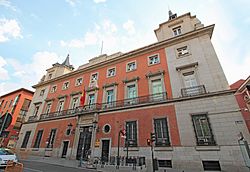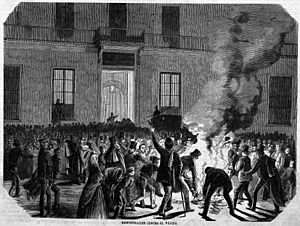Ministry of Justice (Spain) facts for kids
| Ministerio de Justicia | |
 |
|
 Headquarters of the Ministry |
|
| Agency overview | |
|---|---|
| Formed | 30 November 1714 (as Secretary of State and of the Dispatch of Ecclesiastical Issues, Justice and Jurisdiction) |
| Preceding agency |
|
| Dissolved | 20 November 2023 |
| Superseding agency |
|
| Type | Ministry |
| Jurisdiction | Government of Spain |
| Headquarters | Palacio de la Marquesa de la Sonora (Madrid) |
| Annual budget | € 2.5 billion, 2023 |
| Website | Ministry of Justice |
The Ministry of Justice (often called MJUS) was a very important part of the Government of Spain. Its main job was to create and carry out government plans related to the legal system. This included areas like criminal law, civil law, and business law.
The Ministry also helped the justice system work smoothly. It supported legal cooperation both within Spain and with other countries. It handled requests for pardons and managed documents for titles of nobility. These decisions were made by the King and the Council of Ministers.
The Ministry of Justice also gave legal advice to government bodies. It was the main way the government communicated with the General Council of the Judiciary (which runs the courts) and the Prosecution Ministry (which handles legal cases). It also worked with regional governments that had their own justice responsibilities.
The Minister of Justice led the Ministry. The King of Spain appointed this person, usually after the Prime Minister asked him to. The Minister had help from key officials like the Secretary of State for Justice. The last Minister of Justice for this specific ministry was Pilar Llop, who served from 2021 to 2023.
The Ministry's main office was in the Palace of the Marchioness of Sonora in Madrid.
Contents
History of the Ministry
The idea of a government department for justice started a long time ago. In the past, the King had all the power over justice. But over time, kings started to give some of these duties to special officials.
Early Beginnings
The first step towards a Ministry of Justice happened in 1705. King Philip V created a special office to handle "everything else," which included justice and religious matters. This was a very early form of a government department.
The real start of the Ministry was on November 30, 1714. A new rule divided government tasks into four main offices. One of these was the "Secretariat of State and of the Dispatch of Ecclesiastical Affairs, Justice and Jurisdiction." This office was in charge of religious matters, university rules, and how courts worked. It also handled appointments for judges and other legal officials.
This office changed its name a few times. In 1717, it briefly took on financial duties. But by 1720, finance became a separate department again.
Grace and Justice
Important changes happened in 1754-1755 under King Ferdinand VI. The offices were organized more clearly. The justice office became the "Secretariat of State and of the Dispatch of Grace and Justice."
This new office handled many important tasks. It managed appointments for religious leaders like archbishops and bishops. It also oversaw the organization and work of the courts. This included appointing judges and handling legal appeals. The office also made sure that royal laws were followed.
In 1787, there was another change. A new office was created just for justice matters in the Spanish colonies (the "Indies"). However, this didn't last long. By 1790, the original five main offices were brought back, and each handled its own colonial matters, including justice.
Becoming a Ministry
In 1812, the name "Secretariat of the Dispatch of Grace and Justice" officially changed to "Ministry of Grace and Justice." The word "minister" was already being used for these department heads. In 1851, it became official that all these departments would be called "ministries."
The Ministry of Justice stayed mostly the same for many years. Some big changes happened during the Second Spanish Republic (1931-1939). In 1931, it was simply renamed the "Ministry of Justice." For a short time in 1935-1936, it was called the "Ministry of Labor, Health and Justice."
More recently, in 1994-1996, the Ministry of Justice combined with the Ministry of the Interior. This created the "Ministry of Justice and the Interior."
In 2020, the Ministry of Justice stopped being in charge of matters related to religious freedom and the Historical Memory Law.
In November 2023, the Ministry of Justice was closed down. Its responsibilities were moved to the Ministry of the Presidency. This was only the second time in three centuries that the Ministry of Justice was abolished.
How the Ministry Was Organized
The Ministry of Justice had several important parts that helped it do its work:
- The Secretariat of State for Justice: This was a very high-level office that helped the Minister.
- Under this, there was a General Secretariat for Innovation and Quality of the Public Justice Service. This part worked on making justice services better and more modern.
- There was also a Directorate-General for International Legal Cooperation and Human Rights. This office handled legal matters with other countries and protected human rights.
- The Undersecretary of Justice: This office managed the Ministry's daily operations. It handled things like budgets, human resources, and buildings.
- The Office of the Solicitor General: This office provided legal advice to the government. It also represented the government in court cases.
Special Agencies
The Ministry also oversaw some special agencies:
- The Center for Legal Studies: This center helped train legal professionals.
- The General Mutual Benefit Society for Civil Servants of the Administration of Justice: This group provided benefits for justice system employees.
First Notary of the Kingdom

The First Notary of the Kingdom is a special title held by the Minister of Justice. This person's job is to officially record important national events. For example, they record when high-ranking officials, like the King or Queen, the Prime Minister, or other Ministers, take their oath of office.
The First Notary of the Kingdom also recorded important family events for the Spanish royal family. This included births, marriages, and deaths. They also approved legal documents for the royal family, like marriage agreements. These important papers are kept safe in a special office.
The Minister of Justice automatically holds this title while they are in office. This role does not give them the power of a regular notary. It is a symbolic and historical position.
If the Minister is not available, the Director-General of Registries and Notaries can act as the First Notary of the Kingdom.
Recent Ministers of Justice

Over many centuries, many different people have served as the head of the Ministry of Justice or its earlier forms. These individuals played a key role in shaping Spain's legal system. The last person to hold the title of Minister of Justice before the Ministry was dissolved was Pilar Llop, who served from July 2021 until November 2023.
See also
 In Spanish: Ministerio de Justicia (España) para niños
In Spanish: Ministerio de Justicia (España) para niños
- Justice ministry
- List of ministers of justice of Catalonia
- Public Prosecutor (Autonomous Communities of Spain)


